Intarsia is a useful technique when you need to switch between multiple colors to make a larger stockinette stitch motif. In this blog post, you will become familiar with the technique and learn how to read a knitting chart so that you can start knitting gorgeous multi-colored projects.

Now it’s time to take a look at the knitting technique that - if I have to be completely honest - knocked the wind out of me a little when I first heard about it. It’s called intarsia.
Intarsia is a technique used for creating colorful stockinette stitch motifs, which requires you to switch between different colored strands in your work.
Does it seem a little overwhelming? Before your heart starts racing and you get sweaty palms from anxiety, I want to make something very clear: Intarsia isn’t as hard to master as you might think. And the best thing about it - when you’ve mastered the basic principles, you can make all the beautiful patterns that your magnificent brain can imagine.
Get ready for a fun time! 😍
In this blog post, you will get the answers to the following questions:
- What is intarsia?
- How do you knit intarsia? (including a video tutorial)
- Intarsia or jacquard - which technique should I use?
- What can I knit with intarsia?
I would like to start by explaining why intarsia is such a great technique.
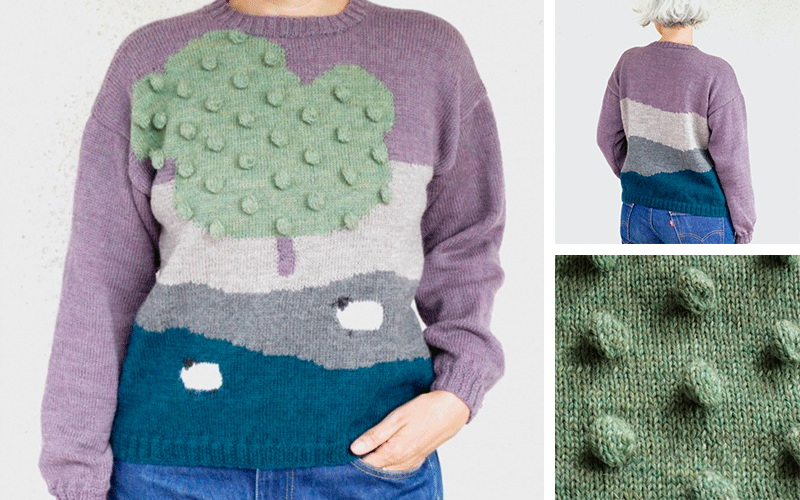
👆 This ‘Sheepy’ Sweater is knit using the intarsia technique. Find the free pattern here.
What is Intarsia?
Intarsia is, as mentioned, a colorwork technique where you work with two or more colors to create a stockinette stitch motif.
The cool thing about this technique is that you - contrary to other colorwork techniques - only work actively with one color at a time. The other colors hang loose in your project until you need them again. You knit separate blocks in different colors, and, thus, intarsia requires a bit of planning in advance. As a result, a knitting chart is indispensable and will be included as part of the pattern.
Psst! The squares in a knitting chart are read in the direction you would knit your work. This means that you must read a knitting chart right to left when you’re on the knitting side (right side) but from left to right when you’re on the purling side (wrong side). Start from the bottom right corner.
When knitting intarsia, you must first study the chart thoroughly. Note how many different colors you will need in the next row and whether you will need the same color multiple times. Each time you need to change colors in intarsia, you will need a new, separate skein of yarn.

👆 A knitting chart may look like this. Try following one of the rows with your finger to find out how many times you will have to change colors.
Tip: Make smaller skeins with knitting bobbins
If you want to give yourself an advantage, you could make some smaller skeins in each color. To do so, you could use a nifty little tool called a knitting bobbin. A knitting bobbin is a brilliant tool when knitting with several colors at once since you can make many small skeins - and perhaps several in the same colors - to make the process much easier. You can buy a set of 6 knitting bobbins here.
Video Guide: How to Knit Intarsia
In this video, you will learn how to knit intarsia:
How to Change Colors Without Creating Holes
When knitting intarsia, you must be careful to not leave a hole when changing colors. You do so by twisting the two yarns around each other, as shown in the video above. That way, you lock the yarns in place and can transition from one color to another easily.
How to add a new color on the right side
- Place the new color strand so that the yarn end is on the right side of your work while your skein or bobbin is on the wrong side.
- Hold the old and the new color in your left hand and place the old color over the new one.
- Continue knitting with the new color.
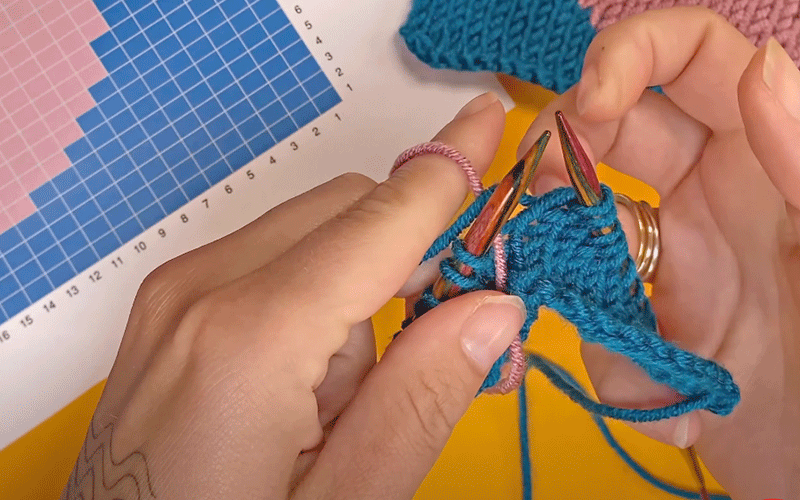
👆 On the right side: Place the yarn end of the new color on the right side of the project. Place the old color over the new one - and continue knitting with the new color.
If you need to add a new strand while you’re working on the wrong side, you must do the same. You must place the yarn end on the right side, which is now turned away from you. Twist the two colors around each other by placing the old color over the new one and continue knitting.
Psst! Don’t worry about the loose threads on the front of your work. When it’s time to weave in the ends, you simply bring them to the wrong side of your work first 😉
How to switch between colors on the wrong side
- Bring the old color to the front of your work (on the wrong side).
- Grab the new color, which is hanging from your work, and place it over the old color.
- Continue knitting with the new color.
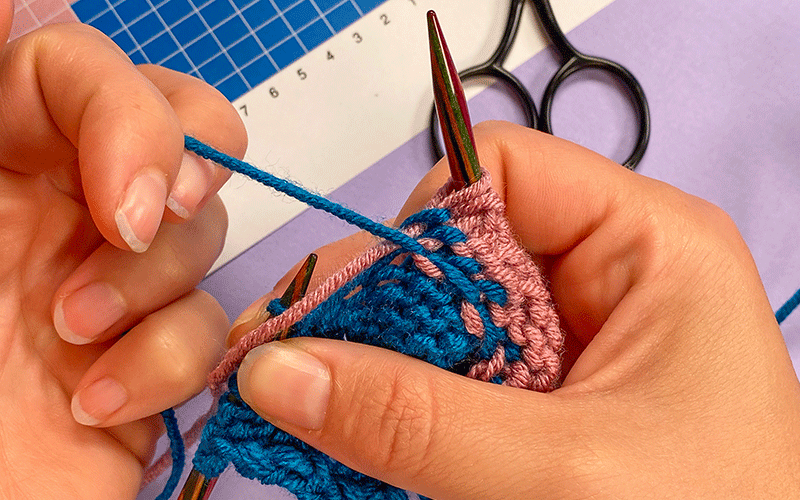
👆 On the wrong side: Change colors by bringing the new color to the right side of the project.
How to switch between colors on the right side
- Place the old color over the new color so that the two colors twist around each other (on the wrong side).
- Continue knitting with the new color.
Tip: Remember to tighten the loose strands slightly to achieve an even texture in your work.
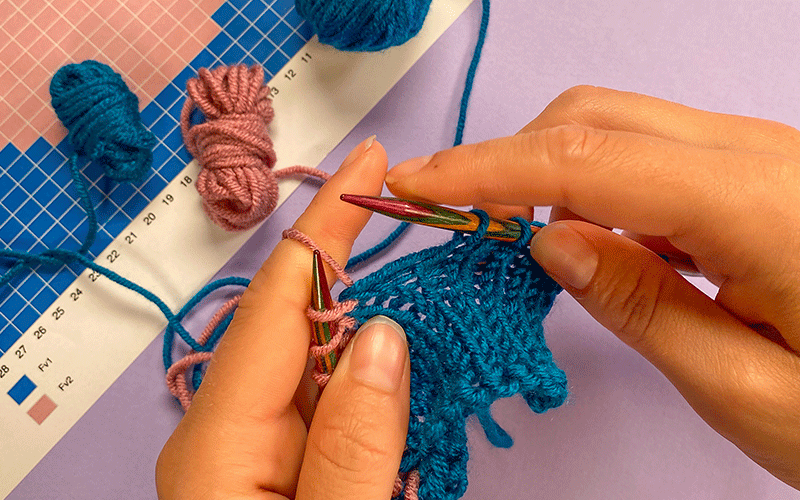
👆 On the right side: Wrap the two colors around each other.
Lock your yarn in place regularly when moving it
When knitting intarsia, it’s a good idea to think ahead. Therefore, it’s a good idea to check where you will need your colors in the next row.
You may end up in a situation where you have to move the yarn on the wrong side, depending on where you need to use that color next. You may have encountered similar challenges in other colorwork techniques.
If you need to move the yarn several stitches over, you should lock the yarn in place on the wrong side of your work regularly. You do so - in general accordance with the intarsia technique - by twisting the two yarns around each other on the wrong side and continuing your knitting from there. That way, you avoid those long, irritating threads on the wrong side of your work. You should lock your yarn in place every 3rd or 4th stitch.
Intarsia or Jacquard. Which Technique Should I Use?
You may already be familiar with the jacquard technique (which is used in Fair Isle patterns) and wonder whether you can’t just use that technique to change colors. And yes, you certainly can, but this technique does, however, have its own advantages and disadvantages.
Jacquard is well-suited for switching between two colors frequently
Jacquard knitting is, among other things, used for Fair Isle knitting. It’s a technique where you work with two different colors and switch between the two colors frequently to create all kinds of different designs.
With this technique, you work with two colors at once, and the color you’re not actively working with is stranded across the back of your work. Since you’re switching between the two colors regularly, it makes sense to strand the non-working color along the back so that the two colors are always readily at hand so that you can switch between the two as needed.
However, jacquard is not well-suited for projects with more than two colors because your project will become very thick and overly bulky - for example, if you’re knitting a sweater, you risk it becoming very stiff and warm.
In addition, this technique doesn’t work well if you have long breaks between the color changes since you will end up wasting a lot of yarn due to the inactive strands on the back of your work. And wouldn’t you rather use that extra yarn for another project?
Another difference between jacquard knitting and intarsia is that jacquard is worked in the round while intarsia is worked back and forth.

👆 When using the intarsia technique, the color changes will look like this on the wrong side.
Save yarn with intarsia
When knitting intarsia, as mentioned, you only work actively with one strand of yarn at a time. This means that you use much less yarn, and can achieve much lighter and airier results.
Thus, intarsia is a great choice when working on large motifs in more than one color with long breaks between color changes.
What can you knit with the intarsia technique?
I’ve gathered some of our patterns with beautiful motifs that you can knit with this technique.
Free intarsia patterns
- Tutti Frutti Strawberry - Vest
- Tutti Frutti Lemon - Vest
- Tutti Frutti Watermelon - Vest
- Sheepy - Sweater
- Ivolo - Bluse
- Love Games - Sweater
- Countryside - Sweater
- Judith - Julebluse
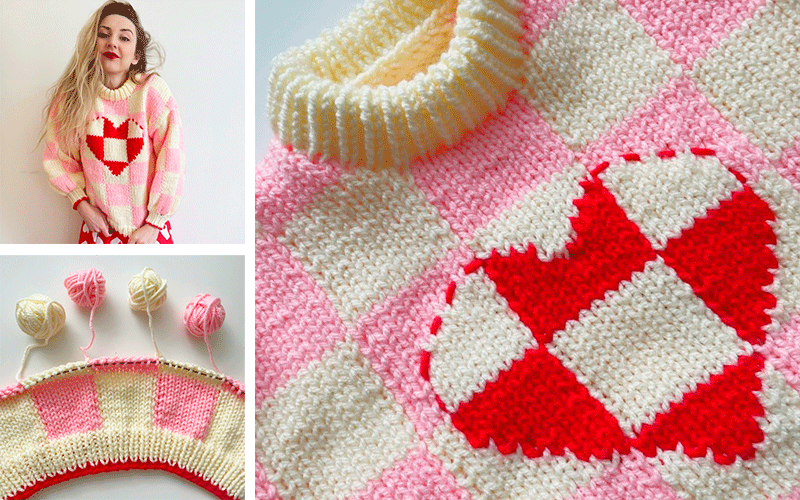
👆 You could knit the pretty 'Love Games' Sweater using the intarsia technique. Design by AnxiousGirlKnits. Find the free pattern here.
Happy knitting!

Leave a comment